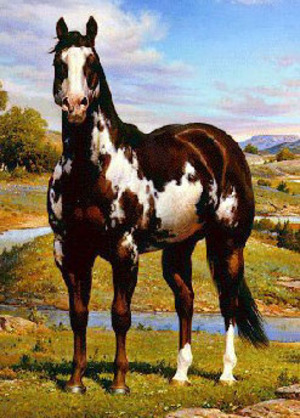Recently a customer came into the store seeking information and a piece of equipment. He was getting a standard donkey to be a guardian to his goat herd, and he needed something to put on her head to lead her around but wasn’t sure what. Another customer jumped in with he needed a hackamore for control. As I tried to redirect the customer to the halters she continued on that he needed a hackamore. Instead of a $10-15 item she was trying to push an item not needed that would have cost $60-70. I had to wonder about her horses if they needed that much control to simply lead them from one pasture to another.
It illustrated there is a great deal of misinformation about horse equipment – and to those dealing with horses for the first time it’s overwhelming. Dressing the head alone brings on hundreds of choices.
A good quality halter is the first basic piece of equipment needed. There are lightweight inexpensive halters for $7-10 that are ok for many horses. A more popular choice is the middle weight “classic” or “premium” halters, nylon with heavier buckles, which are usually more in the $12-20 range. Some have adjustable nosebands, some have a snap at the throat which you can unsnap and slide the halter off over the ears rather than unbuckling the halter each time. These come in standard colors of blue, red, green, maroon, dark blue and black as well as a wide variety of other colors – lime green, orange, neon colors and much more. Among some breeds, Thoroughbreds, traditional leather is favored, with a lighter weight for turnout and a heavier, dressier halter, often with a nameplate, for public functions such as sales. Leather is generally more costly – $15-50 for daily use halters. There are also nylon halters with a leather crown piece (the part that goes behind the ears) designed to break under stress. Rope halters, or the variation of “cowboy halters” with the halter and lead in one piece, are more for leading older, broke well trained horses and tying them long enough to get ready to ride. There are advantages and disadvantages to each. The leather breaks if a horse pulls back, it needs periodic cleaning and conditioning. A nylon has less care required, isn’t likely to break (although under enough heavy stress the buckles and other metal can break). This is an important factor – if you have a horse that pulls back retraining is needed; but you don’t want to reinforce the habit with the reward of being loose when it pulls back. On the other hand, a heavy nylon halter that hooks on something in the field has been deadly for many a horse. Unable to free itself horses have sustained massive ugly head injuries snubbed tight to something that doesn’t give…and when the object or the halter doesn’t give the only thing left to give is the horse. Proper adjustment of the halter is essential – NEVER under any circumstances leave a halter on a foal turned out. The chances of it hanging on something – even the foal’s back leg getting stuck in the noseband as it itches it’s head – is often fatal. The adjustable nosebands are there for a reason but even that is NOT a guarantee of safety. This cannot be stressed enough – a horse, especially a young horse, who is trapped and paniced has the defense of flight removed – the only thing left to do in his mind is fight, or die trying to get loose. This instinct is powerful and often they will not think about hurting you as well. Nylon, for reasons of cost, stregnth and the wide variety of colors, is the most popular halter purchased by horse owners.
Lead ropes have many choices too – there’s a wide variety of nylon lead, cotton leads and leather. For every day use I prefer the cotton, with leather a second choice. The nylon leads are colorful and can be found to match or accent the halters. However, they have a distinct characteristic if you handle your horses without gloves. If a horse acts silly and jerks the rope – these nylon leads (especially the slick feeling ones) will give you a burn you won’t soon forget. If a horse should get it wrapped around a leg, it will equally burn them. This does two things…it HURTS – and the instant reaction when something hurts is…to let go…and instead of playing the line until the horse settles down you in an instant RELEASE HIM, which rewards him for acting up! Cotton and leather can do the same thing but is much harder to do. I prefer the cotton type rope for a mix of safety and durability – it’s stronger if you need to tie a horse up for a moment.
Lunge lines have the same choices…for reasons of cost most people go with the nylon. However, do a couple things to help. Get a good pair of LEATHER gloves and use these religiously when lunging your horse. Also the last 8-10 feet or so of your nylon lunge line tie several knots, a foot and a half or so apart. Simply loop the end around on itself and pull tight, go up a little further and make another one. These knots give a ‘stop’ that helps reduce it sliding through your hands if the horse gets a little silly. Gloves reduce the chances of burns…but equally make sure you keep the horse’s head up so he never gets his foot over the line. If he does, and it burns him it teaches him nothing good.
If you’re lunging a good lunge whip with a lash is an important tool. This is not used to beat the horse!!! With practice you can ‘pop’ the lash, and the noise will get the attention of most horses without ever hitting them. Teach your horse to respect but not fear the whip…you want to use the whip to reach over and touch him, sometimes gently sometimes forcefully, but as an extension of your hand. It’s easier to keep in the proper place to drive your horse forward with a whip – think of it as creating a V – where it joins together is you…one side is the lungeline attaching to the horse’s head, the other side is the whip held driving him forward, occasionally shaking it if he begins lagging. In the open space at the top of the v is your horse.
Bridles, too, have a variety of choices in leather and nylon. Where nylon rules in halters, and a good many people use it for bridles too, leather seems the most popular choice for bridles. For nylon there are flat nylon and braided for the headstalls – and reins in both in “roping rein” and “split reins”. The former is one continuous rein usually with a snap connecting it to the bit on one side. Split reins are longer, with individual longer reins that are not joined together. While nylon is colorful, it lacks the comfort of leather from the standpoint of holding it for extended lengths of time. Leather takes some maintenance – regular cleaning and occasional conditioning – but lasts a long time if cared for. Some believe you must never get leather wet or ride in the rain – which is not entirely true. It DOES take special care to prevent deterioration of the leather, but it’s not impossible. The headstall has further choices in the browband style, one ear and sliding ear styles – with each having their supporters. Keep in mind that for the purpose of this article I am not including any of the MANY choices for show horses in the show ring. This is basic every day equipment.
You’ve pondered the choices and have now the decision of bits – with a variety that is bewildering to many. Entire books have been written on the subject of bitting horses. Ask yourself what level of training he is, and what he’s used to, and what you want to do with him. A very general basic guide – the thicker the mouthpiece the gentler it is, the thinner the mouthpiece the more severe. Equally, the side shanks the longer they are the more severe the bit can be; and with rings the larger the ring the more gentle. Snaffles are often used as a breaking bit because they are gentler, with more give. But make no mistake, the gentlest bit in the wrong hands can do immense damage to a horse. The most severe bit in the right hands will not hurt him. The copper mouthpiece is said to create a soft mouth by inducing saliva – but in the wrong hands the bit does nothing but make the horse drool. The bit is only part of the picture. But generally speaking a small ring twisted wire with a thin mouthpiece is going to have some bite to it where as the larger diameter smooth rubber with larger rings won’t have as much. Remember to think about the mechanics of how the bit works…pulling straight back the snaffle has a scissors action on the horse’s mouth; a bit with a shank and a curb strap works by leverage, putting pressure on the mouth, chin and ears. With a snaffle you pull one rein at a time and it guides, rather than forcing, the horse. Be sure when you’re picking a bit to consider the horse and consider YOU. Always work to educate your hands and be more steady about leaving his mouth and head alone. It’s like people – those who talk all the time we tend to tune out – then there’s those who speak when they have something to say. For your horse, be the latter. I find for an over all just riding bit something like a “Tom Thumb” works with most horses. It has a smooth snaffle mouthpiece, with either steel or copper option there, and a short to medium sized shank. You can use it with individual pulls but it has a little more “bite” than a straight snaffle. I won’t say it works on EVERY horse but it has on hundreds of horses I’ve handled over the years.
Other basic needs – your grooming kit. This I covered in another recent article – but your basic supply should include a rubber curry or mitt, a stiff bristle brush, a soft bristle brush, a hoof pick, mane/tail comb, face brush and towel. With these things and effort you can make your horse shine. You can easily put this together, with a heavy household tote to keep it in, for under $30.
A basic supply kit should be kept on hand at all times (and another article coming on this!). In this kit you will have things basic to all and things for your specific horse(s). Many, but not all, horses need during the dry months a hoof dressing. If the feet get dry, crack or brittle you might adjust your ration for better nutrition but also take the steps to correct it externally. Ask your horse shoer for advice on your particular horse. A good foot dressing, such as Hooflex, can be applied. Keep on hand, and hope you don’t need it, a bottle of Koppertox or other thrush remedy – this is a green liquid that comes in a bottle and will stain so use it carefully! If your horse begins getting thrush – which you will smell when cleaning his feet and once you identify it by smell you won’t forget it! – simply squirt a little of this on the foot, holding the foot up for a minute to let it soak in good. Horsekeeping can be a factor – if bedding is wet pay better attention to getting all the wet out of the stall. But sometimes horses get it standing in mud outside too. Generally it comes on with being in wet mucky footing, which is something to some degree we can control and avoid. Another thing for the kit – a wound treatment such as Blue Kote or Furacin – the latter is bright yellow while the other is a blue/purple. They can be found in aerosol cans as well as sprays, daubers and salves. There are different preferences…I like to keep an aerosol on hand for the light scrapes the horse won’t stand for, or who is outside, as well as a salve. Aloe based veterinary cream is another thing in my must half chest – you can use this on scrapes, on injuries that have begun healing to reduce scarring, on blanket rubs and a wide variety of other boo-boos horses seem to get. Linament is another thing to have on hand – traditionally a liquid now also in a gel form from Absorbine. This can be used for hard working horses as well as for minor sprains. A little linament in a hot bucket of water is a refreshing treat for a horse who has worked hard. Keeping some in a spray bottle makes it easy to spray on a sore leg. IMPORTANT – DO NOT USE THIS ON BROKEN SKIN OR NEAR EYES. It stings like you would not believe. There’s an old adage – if you rub don’t wrap. This means if you use it on a horse’s leg you can wipe it on the leg and wrap it with cotton and a bandage or you can rub it in – but not both. It CAN blister a horse. With that, leg cottons and a bandages are good to have on hand. Have an experienced person, vet or vet tech show you how to wrap a leg and practice it – there is an art to it and done improperly it can have severe and permanent consequences for your horse. It is not difficult. Vetrap is another item to have on hand..at about $2 per roll it comes in many colors but is a useful item to have a dozen or so on hand.
A digital thermometer is good to keep on hand also. With basic supplies you can handle much of the basic things at least until the vet gets to you. Keep these supplies in an accessible but safe, dry place.
Saddle pads come in a wide variety of styles for different purposes – consult with an experienced person to fit pads and saddles to your horse. There are many books and articles about it, but the authors aren’t looking at YOUR HORSE..and your horse doesn’t read. Splint boots and other protection equipment is something else to ask about for your type of riding.
If this sounds like a lot remember a few guidelines – the horse is but a down payment. The supplies needed are ongoing as is feed and housing. Quality products will cost but are an investment in the long run. You are choosing your horse and you owe it to him or her to make him comfortable while he serves you. If you aren’t willing to make that kind of a personal investment consider, honestly, if you are ready to take on a horse. They aren’t just a big dog. They’re like 100 big dogs. Prepare for your horse – then bring him home.





